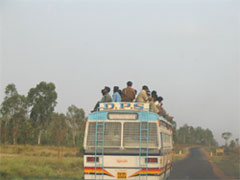Millions of Indians who really want to vote in this election will not. The rural poor, far more than the chattering classes, are the pillars of our electoral system. The vote is the one instrument of democracy they get to exercise. And they do that with telling effect, often using it to go out and change governments. This time, many of them cannot vote. The timing of the polls ensures that. It is in April-May that quite a few distressed regions see their largest exodus of migrant labour.
Millions will be out of their constituencies, seeking work to survive. These are not people who can send in postal ballots. Most cannot afford to return for the polls. If you are a worker from Orissa at a construction site in Mumbai, it is hard for you to vote in this season. (Someone else might vote for you while you are away though not for the party of your choice). This is one result of early Lok Sabha polls.
Sure, migrations are not new. That's all the more reason we should take them into account. They have been around long enough for us to know better. It's important, though, to note that distress migrations have risen since the early 1990s. And exploded since the late 1990s, with the collapse of rural employment. Long before the migrations swelled to an exodus, the National Commission on Rural Labour found (1991) there were "more than 10 million circular migrants in the rural areas alone. These include an estimated 4.5 million inter-state migrants and six million intra-state migrants." And the NCRL report is outdated. It was in the 1990s that the numbers began to grow as never before.

![]()
People forced to migrate cannot wait for reserved seats on regularly scheduled routes. (Picture: Murthy Sudhakar)
Both the Census and the National Sample Survey Organisation grossly underestimate short-term migration. (Ironically, in 2001, such migration was so high in western Orissa, it distorted even the main Census head count in some parts.) NSS data have drawn on a strange definition of `last usual place of residence' of a migrant. That is: "the village where the person has stayed continuously for at least six months immediately prior to moving to the present village/town," where the person is counted. (NSS 43rd round.)
This excludes millions locked into endless step-by-step migrations. People who may not be anywhere for six months. Footloose migrants who are almost always on the move, from place to place, just to survive. But the Census and the NSSO see migration as a single-shot event. Not as a process. So the many moves the migrants make are never captured.
Take the months of April-May last year. Close to two million Oriyas were out of their state looking for work. An underestimate, but it still gives you an idea. Very few, though, were off for six months at a stretch. Barely any were home for six months at a stretch. Lakhs of people from just the three districts of Nuapada, Kalahandi and Bolangir were out. Just for the season. Pulling rickshaws in Raipur. Slaving at brick kilns in Vizianagaram. Working at great risk on high-rise buildings in Mumbai. The same migrants could be elsewhere at another stage of the same season. The way we define them gives us no clear idea of their numbers. Nor of how many of them are denied the vote as a result. We do know the figures are in millions. And rising.
The devastation of agriculture in the last decade makes the problem more acute. Zero investment, collapse of employment, a rise in debt all are factors that have pushed millions more into the footloose army. At the same time, the towns and cities can absorb far fewer of them. There is much less work there, too. So the pressure on the migrants to keep moving only gets worse. Which means they go in for more and more short-term, footloose journeys in search of work.
Meanwhile, this year, we already have The Hindu (Feb. 28) reporting thousands of adivasis in Bolangir leaving their homes "for survival." That's in February. What could it be like by April-May? Can these people vote?
In that season last year, I boarded a bus for Mumbai from Mahbubnagar in Telangana. The idea was to join the migrants leaving the district in despair and hunger. Whole villages had seen more than two-thirds of their residents leave, looking for work. Only the very old and some young remained. Every traveller on that bus was a migrant wanting work or a child of such migrants. Every bus on the route (with 58 seats), carried up to 100 passengers or more. The season brought record revenues for the Andhra Pradesh State Roadways and Transport Corporation there on one-way tickets (most went back in under six months, though. Only to move out again in their quest for survival.)
Millions of poor Indians have already voted with their feet. They've left their homes in despair. Forced by a system that causes them such distress. One that tries, at every turn, to disable them and curb their democratic rights.
• The bus to Mumbai























